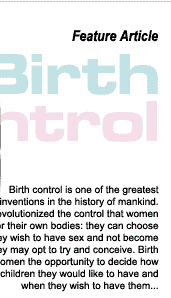|
Although both men and women share equal roles in procreation, and
should therefore be equally responsible to take proper contraception,
this responsibility often falls on the woman's shoulders. This is
probably because she is the one who has the most at stake and it
is she who ultimately must bring a child into the world if birth
control is not used.
There are many forms of birth control currently on the market,
some methods having been used for decades, while others are relatively
new. While this article does not provide detailed information about
each method of birth control, its purpose is to compare the basic
facts regarding the various methods, including pros and cons of
the different contraceptives available. The purpose of this article
is to help inform women who may wish to have children sometime in
the future, but do not want them at the moment. Therefore, we will
be only reviewing non-permanent, reliable methods of birth control,
eliminating such methods as sterilization, withdrawal method, rhythm
douching and breast-feeding. These birth control methods will be
reviewed separately.
Method: The Birth Control Pill (The Pill)
What is it?: A pill that contains synthetic estrogen and
progestogen
How does it work?: The pill comes in packages using cycles
of 21 or 28 days that must be taken daily. The hormones in the pill
prevent your body from ovulating, which means that an egg is not
released each month and pregnancy will not result.
Effectiveness: 97-99% effective
Advantages: Easy to use, regular and lighter menstrual cycles,
reduced cramping, link to reduced rates of uterine and ovarian cancer,
may clear up acne, allows for spontaneous sexual activity.
Disadvantages: Possible weight gain, must remember to take
pill every day, less effective when taken with antibiotics, does
not protect against STD's, and requires a prescription, possible
side effects.
Method: Depo-provera
What is it?: An injection containing progestin.
How does it work?: An injection is given every 12 weeks, which stops
the body from producing estrogen and progesterone. As a result,
ovulation does not occur, as no egg has matured for release and
the uterus lining is not able to receive a fertilized egg.
Effectiveness: 99% effective
Advantages: no chance of forgetting to take a pill, no chance
that the method will be used incorrectly, injection only 4 times
a year, decreases chances of ovarian and uterine cancer, may be
used by women who are breast feeding, highly discreet, permits spontaneous
sexual activity.
Disadvantages: all women will experience prolonged menstrual
bleeding and spotting between periods, followed by many women having
irregular menstrual bleeding or even none at all, injection must
be given by physician, does not prevent STD's, there is nothing
to reverse the injection if it doesn't agree with you and it takes
12 weeks to wear off, possible delay of fertility after last injection,
various side effects.
Continue
|




